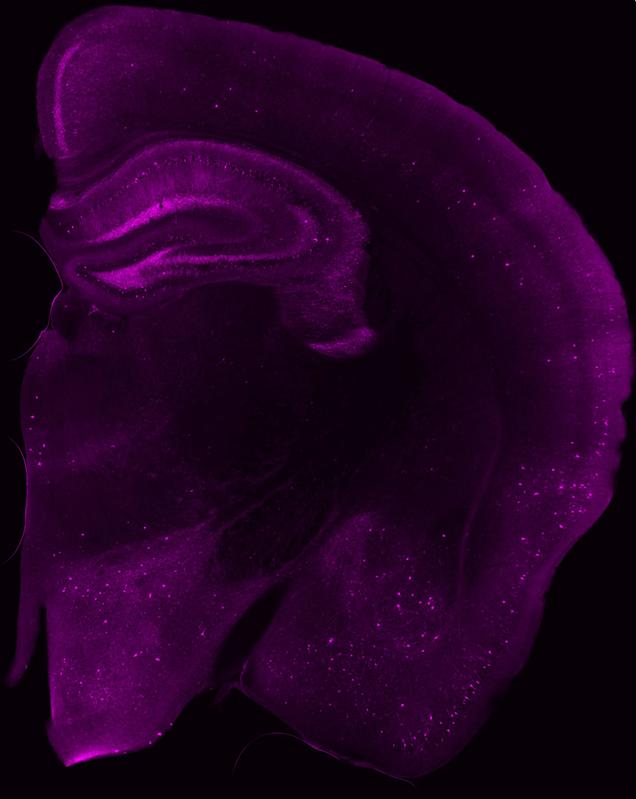Experimental drug ameliorates symptoms of neurodegenerative brain disease in mice

A look inside of a mouse brain: tau proteins are enriched in the magenta areas. They are particularly highly concentrated in some of the neurons (light spots). The dendrites (filamentous processes DZNE/Jens Wagner
“We have found that this substance prevents the aggregation of tau proteins. This aggregation is typical of Alzheimer’s and other brain diseases classified as tauopathies,” explains DZNE researcher Dr. Martin Fuhrmann, who worked on this study with colleagues at the Ludwig-Maximilians-University Munich (LMU) and the Max Planck Institute for Biophysical Chemistry in Göttingen. “Treatment with anle138b could be one way of intervening in the progress of the disease.”
Effect on pathologically altered protein
Under normal conditions, the tau proteins stabilize the microtubules that are part of the cytoskeleton of neurons in the brain. The cytoskeleton gives the cell mechanical stability and serves as a transport network for substances essential to the cell’s metabolism.
However, in cases of Alzheimer’s disease and other tauopathies, the tau proteins have undergone an alteration: they become detached from microtubules and aggregate into filamentous tau-tangles. As a result, the microtubules’ function and the cell’s metabolism are impaired, which eventually leads to neuronal death.
Amelioration of disease symptoms
“The experiments were inspired by our earlier studies that showed high efficacy against the formation of pathological protein aggregation,” says Prof. Armin Giese from the Center for Neuropathology and Prion Research at the LMU Munich. “These led us to suspect that anle138b could prevent the aggregation of tau proteins.”
The mice treated by the scientists had a genetic defect that caused them to display various characteristics typical of tauopathies, the same as those that manifest in humans. Besides aggregation of tau proteins, these include cognitive disorders and a shorter life expectancy. It turned out that the substance, which was administered in the mice’s food, not only works at molecular level but also influences disease symptoms. “The mice’s working memory skills improved and they lived longer,” says Fuhrmann. The scientists also found that the treated mice had less neuron loss than those that had not been treated.
Disease development apparently slowed
“In contrast to other substances Anle138b is orally available because of its chemical and metabolic characteristics. Therefore, it stays for hours within the body and targets specifically protein aggregation”, says Prof. Christian Griesinger from the Max Planck Institute for Biophysical Chemistry, whose team synthesized the substance.
“Anle138b cannot stop the disease from progressing in the animal model, but it seems to slow it down,” says DZNE scientist Fuhrmann. “Anle138b is therefore a possible starting point for the development of drugs that prevent the aggregation of tau proteins.” However, the results from mice are not directly transferable to human. “The efficacy and tolerance for humans have to be tested in demanding clinical trials. Even with an optimistic perspective it will take years until a treatment for patients might be available.” Currently, a joint venture of LMU and MPG develops the drug Anle138b further.
Original publication
Reducing tau aggregates with anle138b delays disease progression in a mouse model of tauopathies
Jens Wagner, Sybille Krauss, Song Shi, Sergey Ryazanov, Julia Steffen, Carolin Miklitz, Andrei Leonov, Alexander Kleinknecht, Bettina Göricke, Jochen H. Weishaupt, Daniel Weckbecker, Anne M. Reiner, Wolfgang Zinth, Johannes Levin, Dan Ehninger, Stefan Remy, Hans A. Kretzschmar, Christian Griesinger, Armin Giese, Martin Fuhrmann.
Acta Neuropathologica, DOI:10.1007/s00401-015-1483-3.
https://www.dzne.de/en/about-us/public-relations/meldungen/2015/press-release-no… Link to release
http://link.springer.com/article/10.1007%2Fs00401-015-1483-3 Link to paper
Media Contact
All latest news from the category: Life Sciences and Chemistry
Articles and reports from the Life Sciences and chemistry area deal with applied and basic research into modern biology, chemistry and human medicine.
Valuable information can be found on a range of life sciences fields including bacteriology, biochemistry, bionics, bioinformatics, biophysics, biotechnology, genetics, geobotany, human biology, marine biology, microbiology, molecular biology, cellular biology, zoology, bioinorganic chemistry, microchemistry and environmental chemistry.
Newest articles

Properties of new materials for microchips
… can now be measured well. Reseachers of Delft University of Technology demonstrated measuring performance properties of ultrathin silicon membranes. Making ever smaller and more powerful chips requires new ultrathin…

Floating solar’s potential
… to support sustainable development by addressing climate, water, and energy goals holistically. A new study published this week in Nature Energy raises the potential for floating solar photovoltaics (FPV)…

Skyrmions move at record speeds
… a step towards the computing of the future. An international research team led by scientists from the CNRS1 has discovered that the magnetic nanobubbles2 known as skyrmions can be…





















